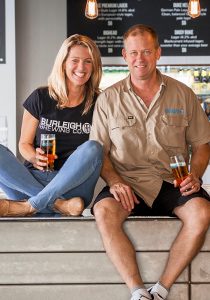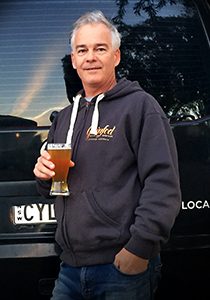Price growth edges lower despite reasonable economy

Insight
The craft beer industry has exploded in Australia. Four brewers explain what’s driving demand, where the sector is headed and what others entering the industry might consider.
It wasn’t that long ago, to quote a Deloitte report, that Australia’s craft beer industry largely comprised “beer lovers who tinkered with their home brew kits and methods”. Nowadays, those tinkering beer lovers are listing on the stock exchange, constructing state-of-the-art, eco-friendly breweries and exporting their products around the world.
The Australian craft beer industry is young. In 1983 brewer Phil Sexton and a collection of university friends launched what is acknowledged as Australia’s first craft brewery at the Sail & Anchor pub in Fremantle, Western Australia. Sexton and partners went on to launch the Matilda Bay brand, then Little Creatures, and other microbreweries began opening across the country. The marketing push by established players that had either bought craft brands such as Matilda Bay, or helped produce them, such as master brewer Chuck Hahn’s James Squire label, (created for Lion Nathan), greatly benefited the sector.
By 2006 the number of Australian craft brewers had grown to 30, and today has swelled another 14 times to 420, according to the Independent Brewers Association (IBA). This financial year, craft brewers are predicted by IBISWorld to enjoy revenues of $454 million, while one in 10 beers now sold in Australia is a craft beer (though it should be noted that a significant number of craft beer brands are owned by multinational brewing behemoths). In all, some industry experts predict that craft beer’s share of the beer market will double over the next 10 years; certainly, the IBA’s goal is to increase independent beer’s market share to 15 per cent by 2025.
Here, four craft brewers – Ballistic Beer’s David Kitchen, Burleigh Brewing’s Peta Fielding, Broo Ltd’s Kent Grogan and Grainfed Brewing Company’s Lachlan MacBean – explain the industry’s challenges, opportunities and rewards.
David Kitchen qualified as an accountant, worked at the Department of Foreign Affairs and Trade, then ran a chain of home-brewing-supplies outlets before launching Ballistic Beer. Peta Fielding is a former corporate finance lawyer. Kent Grogan once owned a financial services business. Lachlan MacBean studied horticulture at university and spent years working as the sales manager for his family’s tree nursery business.
You could pick any four Australian craft beer company owners at random and find they shared similarly varied but impressive backgrounds. Typically, craft brewers are go-getters with business experience who’ve chosen to part ways with the traditional corporate world. They see craft brewing as a ‘lifestyle business’, at least to the extent it allows them to oversee an enterprise that reflects their values and vision.
For as little as $20,000 to $30,000, someone can become what is known as a ‘gypsy brewer’. That is, they can come up with a recipe for a craft beer and pay an existing brewery to produce, bottle and label it. They can then try their luck selling it to friends, family members, pubs and bottle shops.
Building a microbrewery and setting up a brewpub (an establishment that sells craft beer and food) will usually require at least $1,000,000. But that’s hardly an insurmountable capital barrier, especially for high-flying professional types or those who’ve already built and sold a business. Once they’ve established a relationship with a brewery or constructed their own, a craft beer business can distribute their product regionally, statewide, across the nation or, if they’re particularly ambitious, internationally.
The craft beer industry has been exploding at the same time as Australians’ overall consumption of beer has been falling. That’s less paradoxical than it seems when you consider what Kitchen calls the MasterChef effect.
“When I was growing up, food and beverages were all about convenience; people wanted instant coffee and frozen TV dinners,” he explains. “These days, Australians are much more engaged with what they are eating and drinking and hope to derive a lot more enjoyment from it. With craft beer, you can go down to the brewery where it’s produced. You can meet the guy who has brewed what you’re drinking. You might even be able to go on a tour of the brewery and see the natural ingredients and lack of chemicals being used in the brewing process. You can sit and enjoy your beer with other members of the local community. That’s not an experience consumers get purchasing a generic carton of beer at the bottle shop to drink at home.”
Fielding believes consumers’ desire for artisanal food and drink is connected to a wider yearning to be part of a community.
“You see this dynamic playing out with a lot of other products, from coffee to ice cream,” she says. “Consumers are now asking questions such as, ‘What’s in it?’, ‘Who makes it?’ and ‘What is this business doing for the community?’ There’s a growing appetite for substance and authenticity. That informs the way Burleigh Brewing operates. We support the Gold Coast community we’re part of. We try to do everything – from sourcing ingredients to packaging – as close to where we are as possible. We provide employment, fund local clubs and offer a welcoming space where Gold Coast residents can get together for after-work drinks, art shows, birthdays, film festivals, gigs by local bands, even weddings.”
Ask craft brewers whether they have helped generate or just taken advantage of shifts in consumer tastes and they’ll tell you it’s a chicken and egg conundrum. Immediately after this, they’ll point out that, whatever favourable winds they’ve had at their back, craft brewers’ success has been hard won.
“When I was a young lad in Queensland, you only drank XXXX,” Kitchen says. “You’d be bagged by your mates if you experimented with any other beer. That mindset didn’t just magically change. Craft brewers put a huge amount of effort into educating consumers. That’s involved everything from harnessing the opportunities provided by social media to putting on free or low-cost brewery tours to training up bar staff to talk to people about the beer they’re ordering in brewpubs.”
“When you look at places such as Oregon,” MacBean adds, “where craft beers account for 43 per cent of the market, you realise there’s still plenty of room for the Australian industry to grow. But I’m concerned at the number of people without the necessary business or brewing knowledge, and with no point of difference, who’ve decided this is a trendy industry that they want to be part of. That is making significant industry consolidation inevitable down the track.”
What was the Craft Beer Industry Association recently changed its name to the Independent Brewers Association. Fielding, who was Chair of the Association for three years, says that happened because “’craft’ had been adopted as such a broad marketing term it had lost all meaning”.
Describing certain beers as craft beers is problematic for two reasons. First, many craft brewers have been snapped up by what the Independent Brewers Association likes to refer to as “global brewing concerns”. They may or may not still be craft brewers but they certainly aren’t independent ones anymore. On the other side of the equation, some of the Independent Brewers Association members have grown so large it doesn’t make much sense to label them craft operations any longer.
Grogan, who listed Broo on the ASX last year and says he is well on his way to cracking the Chinese market, has given a lot of thought to what still separates businesses such as his from what are referred to as ‘the majors’ (Australia’s traditional duopoly of Foster’s/Carlton and United Breweries, now owned by Anheuser-Busch InBev, and Lion).
“It’s debatable whether a brewer operating at the scale of Broo can still be called craft but it’s definitely independent,” he says. “Even though I’m unashamedly trying to grow the business and provide a return to shareholders, there’s still a lot of passion that goes into the brewing process. There’s still that obsession with producing a quality beer, rather than just the bottom line.”
Grogan also points out Broo continues to make ‘sessionable’ beers. That is, “full-flavoured, sophisticated beers meant to be savoured rather than slammed down”.
Established: 2015
Run by: David Kitchen
Target market: Brisbane first, then Australia

When David Kitchen’s wife wanted to return to Australia, he handed in his notice to the Department of Foreign Affairs and Trade. Back in Brisbane, he built a chain of home-brewing-supplies stores.
“The logical next step was to create a brewery that home brewers wanting to become gypsy brewers could use,” he says. “But I got carried away, partnered with a brewer and created my own craft beer business.” Kitchen’s plan is to establish a “strong beachhead” in Brisbane then conquer the rest of the country.
Like many craft brewers, Kitchen is simultaneously bullish about the industry and hesitant about encouraging others to enter it.
“There will eventually be 600 to 700 craft beer businesses in Australia. Of course, only a small fraction of those will have a presence beyond their neighbourhood,” he says. “Nonetheless, I expect craft beers to get to a 25 per cent market share over the next decade. However, I wouldn’t advise someone to get into the industry just because they like making beer and serving it up to their friends.
That’s a small fraction of what running a craft beer business involves. You can expect to be working 24/7, trying to keep your head above water for three to five years, at which point you just might start turning a profit.”
Established: 2006
Run by: Peta and Brennan Fielding
Target market: Australia (but with a focus on the Gold Coast)

Around the turn of the millennium, Peta Fielding was studying for an MBA in Hawaii when she fell for Brennan Fielding, an American craft brewer. “The craft beer scene is more mature in the US and Brennan couldn’t believe my hometown, with a population of 500,000, didn’t have a single brewery,” she says. “So we moved back to the Gold Coast and started one.”
Fielding hasn’t forgotten the grind of those early years. “It was just the two of us, making, packaging and trying to sell the beer. We’d go to bottle shops and hand out samples. Australians would refuse free beer because they didn’t want to try anything different back then.”
Fielding has never been interested in “just creating a commodity that would be sold in markets we had no presence in or commitment to”.
“Growing up I dreamed of creating a business, creating something new that didn’t exist before,” she says. “I wasn’t focused on a particular product but it’s turned out to be craft beer, which I get to make with my hubby. It’s pretty cool to have created a well-respected brewery that serves the Gold Coast community.”
Established: 2009
Run by: Kent Grogan and Kelly Davidson
Target market: Australia and China

Kent Grogan is proud of his blue-collar background and he’s got his sights fixed on the kind of true-blue beer drinker who’s traditionally downed VB, XXXX or Tooheys New.
It’s an approach that’s paying off. Broo listed on the Australian stock exchange in late 2016. It is spending $100 million to construct a solar-powered brewery in Ballarat. It has also partnered with the giant Jinxing Beer Group to distribute Broo beers throughout China.
“I used to have a large financial services business, overseeing 490 brokers, but I reached a point where I’d had enough. I wanted to do something I loved and I’d always loved beer,” Grogan says.
Like most craft brewers, he’s frustrated at what he perceives as the majors pressuring pubs not to put craft beers on tap. (A recent ACCC investigation found that the majors did incentivise pubs to sell their product. However, it stopped well short of concluding the majors were locking independent brewers out of the market.) Nonetheless, he credits them with inadvertently turbocharging the growth of Australia’s craft beer industry.
“The majors had the budgets to promote the beers such as Little Creatures and Fat Yak,” he says. “They marketed them as these left-field, independent beers people should try. A proportion of drinkers, who might otherwise have stayed rusted on to the big brands, did try them. That changed consumers’ drinking habits and meant they were then willing to try other craft beers.”
Established: 2012
Run by: Lachlan MacBean
Target market: Newcastle and surrounds

A long-time home brewer, Lachlan MacBean decided to turn pro in his mid-thirties. “I did a course in brewing science at the University of Ballarat then talked my way into a job as a brewer at Bluetongue Brewery,” he says.
After almost six years at Bluetongue, MacBean set himself up as a gypsy brewer, launched Grainfed and began supplying pubs and clubs throughout Newcastle.
“I’m doing well enough, but to have a long-term sustainable business you need your own brewery and brewpub,” he says. “I’m in the process of partnering with others to finance those facilities. But I don’t have any big ambitions to conquer the world. I’d be happy to be the craft beer of choice for Newcastle and Hunter residents.”
Despite having worked for a craft brewery jointly purchased by Coca-Cola Amatil and SAB, MacBean warns that big paydays are rare.
“I’m sure the majors are looking for more craft brewers to buy,” he says. “But to be an acquisition target, the craft brewer will already need to have made the substantial investment required to become the kind of well-equipped, high-volume operation that’s easy to scale up. Craft brewing is fulfilling and fun, but the reality is it also involves some rejection and frustration and lots of hard work. Few people get seriously rich from it.”
This article was first published in Business View magazine (Issue 24).
© National Australia Bank Limited. ABN 12 004 044 937 AFSL and Australian Credit Licence 230686.